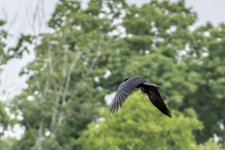You are using an out of date browser. It may not display this or other websites correctly.
You should upgrade or use an alternative browser.
You should upgrade or use an alternative browser.
Post your Birds in Flight
- Thread starter Marilynne
- Start date
The duck in the background doesn't help either.
Good job on the pigeons.
This is my first bird in flight shot ever. Compared to you guys it's kind of low grade, but I'll keep practicing and get better. (maybe)
View attachment 91480
View attachment 91481
It's a good start. I must have taken 30-40 or more before I had one in focus.
This is my first bird in flight shot ever. Compared to you guys it's kind of low grade, but I'll keep practicing and get better. (maybe)
View attachment 91480
View attachment 91481
Great first shots,do you have any seagulls where you live they are the best to start with
It's a good start. I must have taken 30-40 or more before I had one in focus.
I don't know how some can get the eye in focus, when it's hard to get the whole bird in focus.
Great first shots,do you have any seagulls where you live they are the best to start with
I wish. Florida would be a great place to be doing this. They have large birds that fly so close that sometimes you have to duck to not get flown into. LOL
Great first shots,do you have any seagulls where you live they are the best to start with
Or pigeons.
I don't know how some can get the eye in focus, when it's hard to get the whole bird in focus.
It is how you set your camera up. You need to be able to control the focus point to where it will focus on a small area and stay focused on that point.
You must have good control of the camera functions and enough DOF to keep the bird in focus. At the distances you photograph birds from DOF becomes very thin and any slight difference between distance from one end of the bird to the other makes a huge difference in focal plane. That is why you must focus on the eye and at least have that part in focus.
I personally use Single Point AF (Single Point area instead of Auto Area), Continuous Servo (AF-C) and I use Aperture Priority with Back Button Focus control.
Once I see my subject I aim and get the bird in frame. I make sure to put the center focus point on the eye or at least at the beak of the bird. Make sure you can track your target with panning. Keeping the focus point on the eye or beak will keep the area in focus. Set your camera for your fastest frame advance rate and set the shutter button to high speed burst mode. Get focus with the Back Button method then you can use the shutter button separately and fire off a few frames while panning the bird.
If the bird is just too far away or the background is just too busy this will not work. You must be close enough to the bird and the background has to allow you to maintain focus on its eye or beak. Moving tree branches, because they are larger and may have more contrast than the birds eye, can and will cause focus to jump from the bird to the branch. The better the AF system the less this is likely to happen.
Dynamic or 3D Tracking modes tend to allow focus to jump around, at least on my D90's AF system. That is why I use Single Point.
Michael J.
Senior Member
Mike, such great shots











